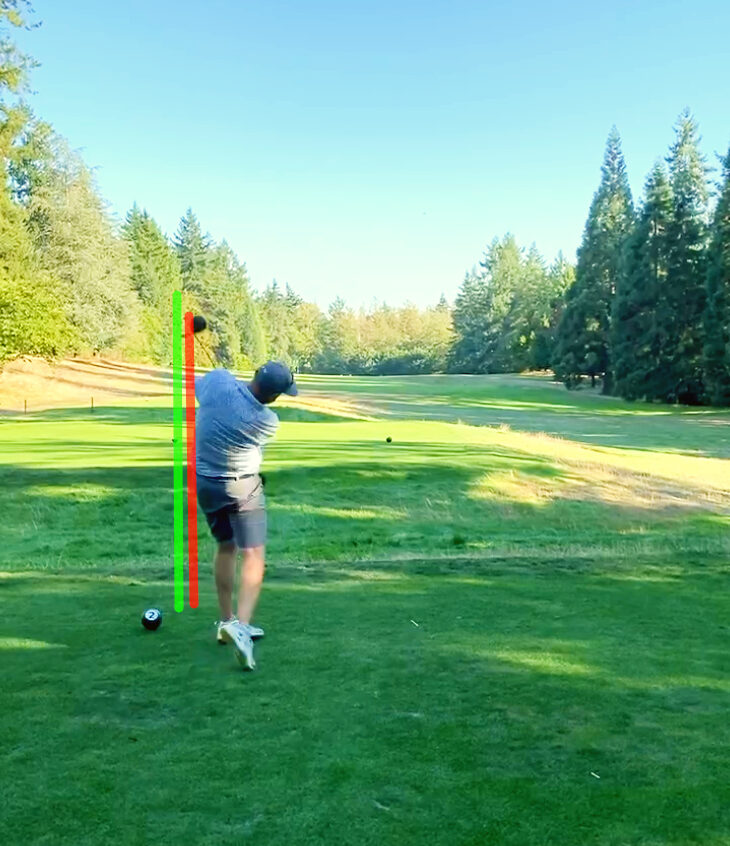Your local Kitsilano Physiotherapy Clinic: Seven Summits Rehab and Health’s Golf TPI Assessment

Slicing or hooking the golf ball? Never heard of a TPI Golf Assessment? Then this blog is for you!
 The most common characteristic I see when assessing golfers’ swings is ‘early extension’, which is a movement towards the ball on either the backswing or downswing. This results in the arms getting stuck behind the body in the hitting zone and the trunk is then forced to raise up, which can lead to the dreaded hook or slice. As you can see from this picture on the left, the green line represents this golfer’s initial set-up posture, and the red line shows his excessive movement towards the ball on the downswing.
The most common characteristic I see when assessing golfers’ swings is ‘early extension’, which is a movement towards the ball on either the backswing or downswing. This results in the arms getting stuck behind the body in the hitting zone and the trunk is then forced to raise up, which can lead to the dreaded hook or slice. As you can see from this picture on the left, the green line represents this golfer’s initial set-up posture, and the red line shows his excessive movement towards the ball on the downswing.
As a Titleist Performance Institute (TPI) golf instructor and physiotherapist, it is my job to find the connection between this ‘early extension’ and the possible physical reasons. The main areas I see that cause this problem include reduced spinal and hip mobility, and reduced firing of the glutes. With reduced spinal and hip mobility, if the golfer cannot keep their posture angles on the swing because of stiffness, they will have to compensate. This then leads to a negative knock-on effect that affects the golf stance, as forward and lateral movement patterns tend to take over the swing. Due to the stiffness, the golfer is unable to stabilize through the lower body, while the upper body rotates alone leading to limited rotation – we want to be able to separate different parts of the spine and pelvis to allow for greater rotation.
Additionally, to keep the lower body stable to prevent these forward and lateral movement patterns, the glutes need to stabilize our body as we rotate. Weak glutes will, therefore, cause the body to move into undesirable positions for the golf swing. We lose posture and become closer to the ball, which leads to early extension and the hook/slice will take over.
A simple method of checking whether your glutes are firing correctly is to complete a single leg bridge. Lying on your back with knees bent together at approximately 90 degrees. Arms straight up into the air and then lift your hips. While you are in the bridge position, straighten one leg in the air, and check these areas:
 ➢ Does your pelvis remain level or does it drop towards the floor on one side?
➢ Does your pelvis remain level or does it drop towards the floor on one side?
➢ Any cramping in the hamstring, calf or is the back really tight and taking over the movement?
➢ Is the glute engaged and stable – you should be able to hold this for a minimum of 10 seconds on each side without any compensations.
If after performing the above exercise, you find weakness in the glutes and you have ‘early extension’, then this is one connection for you to focus on.
As physiotherapists, we target body mechanics because it is vital to try and improve these limiting areas of the body rather than learning a way around them. A stiff spine, reduced hip mobility and weak glutes are three vital areas of the body that we commonly see. More importantly, these will lead to injury at some point and are contributing causes to that hook/slice affecting your golf scores.
At Seven Summits Rehab and Health, your local Kitsilano physiotherapist, we analyze your golf swing, assess your physical abilities using the TPI screening method, and use the results to connect the areas where you are struggling to create a treatment plan.
To treat, we may use a variety of techniques including manual therapy, clinical Pilates reformer, dry needling, and an emphasis on golf-related exercises to target strength, stability and mobility. If you need any more information on the TPI Golf Assessment or just want to chat further about it, book today for your TPI Golf Assessment.
Call: (778) 800-8817
Email: info@sevensummitsrehab.ca


